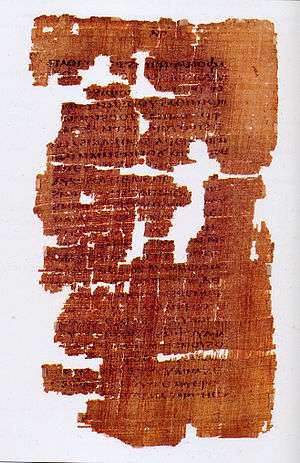Acts of Barnabas
The Acts of Barnabas is a non-canonical pseudepigraphical Christian work that claims to identify its author as John Mark, the companion of Paul the Apostle, as if writing an account of Barnabas, the Cypriot Jew who was a member of the earliest church at Jerusalem; through the services of Barnabas, the convert Saul was welcomed into the apostolic community. Three pseudepigraphical works are linked with the name of Barnabas: the Epistle of Barnabas, written between AD 70 and 135, this Acts and the medieval text Gospel of Barnabas.
The language and the ecclesiastical politics of Acts of Barnabas reveal it to be a work of the 5th century, designed to strengthen the claims of the church of Cyprus to apostolic foundation as the site of Barnabas' grave, and therefore of its bishops' independence from the patriarch of Antioch.[1] These are 5th century concerns, the independence of the Church of Cyprus having been declared by the First Council of Ephesus in 431 and confirmed by Emperor Zeno in 488.
Some have mistakenly assumed that the reference to a gospel used by Barnabas referred to in the Acts of Barnabas was the medieval document, the Gospel of Barnabas. However, this is clearly false, as the quotation reveals:
- Barnabas, having unrolled the Gospel, which we have received from Matthew his fellow-labourer, began to teach the Jews.
By omitting this emphasized phrase in quoting this passage, the impression may be given that there is a Gospel of Barnabas earlier than the so-called "Decretum Gelasianum", an agenda for those who would maintain the late Gospel's authenticity.
References
- István Czachesz (2002). "The Commission of John Mark in the Acts of Barnabas" (PDF). Apostolic commission narratives in the canonical and apocryphal Acts of the Apostles. University of Groningen. Retrieved 19 July 2018.
